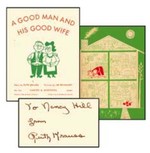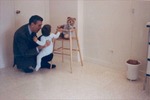Experimental filmmaker Stan Brakhage is probably not remembered best for being the film teacher of South Park creators Matt Stone and Trey Parker["We need a montage!"]. And he's also not known for what may be his greatest contribution to the world of moviemaking, if not "cinema": the birth film.
For his entire career, throughout most of his 400+ films, Brakhage focused on the very personal act of seeing, the daily process of understanding the world around us by experiencing it visually. He incorporated and collaborated with the people around him--first friends, then his wife, his kids, and his other wife and other kids--to make his poetic, usually silent films.
In addition to their lives, Brakhage filmed the births of all five of his children with his first wife Jane. I didn't realize how remarkable this was until I started looking into the story of the first one, which Jane discussed as The Birth Film, but which was released under the title, Window Water Baby Moving. [Andy had linked to it on Stork Bites Man a few days ago.]
With his no-holds-barred view of Jane Brakhage's labor and delivery, the filmmaker set out to capture the father's experience--his experience--as a viewer of his partner and this remarkable event. On the Criterion DVD commentary, Brakhage brags that Window Water Baby Moving was instrumental in the cultural shift to let dads be present in the delivery room. It's also one of the first times, if not the first, parents filmed the birth of their own child. In the ensuing 50 years, of course, and with the introduction of the camcorder, the dad-filmed birth has become a film genre all its own.
Here's some of the story of how it started...
Window Water Baby Moving was filmed 50 years ago, in November 1958, in the Brakhage's Greenwich Village apartment. Stan and Jane had already collaborated on several films together about themselves and their relationship, when they decided together to film Jane's pregnancy and the birth of their first child. [Note: for several key production details and for all of Jane Brakhage's quotes, I'm relying on Shira Segal's paper on WWBM published at albany.edu. Segal in turn quotes Jane's 1963 account, "The Birth Film," published in the Film Culture Reader, which is not online.]
When they found out neither Stan nor his camera were permitted to enter the hospital delivery room, they arranged for a home birth attended by a doctor. The first part of the film, of Jane resting in the bathtub, was actually shot the day before the birth:
By the afternoon of November 12, we had taken some moving pictures of the baby moving and kicking before being born, and that night there were contractions, and we were very happy and took some more film of our happy faces and some of the cat and played games and watched the clock...It's worth noting that Jane filmed Stan, too, not just the other way around. The next day, during the birth:
Clickety-clackety-buzz goes the camera. Something tremendous is happening to me. I have entered into a world of beautiful agony - agony of great beauty, joyous agony, unbearable beauty. I roar like a lion. Stan films, clickety-clackety-buzz, his hands are trembling with the camera, but clickety-clackety-buzz anyway. I roar again and pant fast like I had run a mile and roar, and Stan films, and we are so very happy because the baby is coming at last!Segal tells about Brakhage filming the actual moment his daughter emerges, where his dual identity as filmmaker and father collide:
Brakhage's use of the hand-held camera causes the images in Window Water Baby Moving to be inherent to the filmmaker's body and the emotions experienced by his body. This moment in which Brakhage nearly drops the camera provides an acted out example of Brakhage's belief, according to Elder, "that all emotional experiences register in vision, that emotion and seeing are integral to one another" (1998, 448). Brakhage's bewilderment is experienced throughout his body and is extended to the hand-held camera which records it.Immediately after giving birth, an exhausted Jane still has the presence of mind to grab the camera and film Stan's giddy reaction, a feat he commented on for years following.
Such was the taboo on filming or depicting a birth in 1958, though, that the film processor threatened to confiscate the film and report Brakhage for obscenity. He only got his footage back after the doctor intervened, claiming the film was for medical training purposes. Brakhage faced similar outrage when he screened the movie the next year for his avant garde colleagues.
While he talked years later about the "outrage" that fathers couldn't attend their childrens' births, I'm kind of struggling to connect the dots between the rareified audience for under-appreciated experimental films and the eventual cultural shift that opened the delivery room to dads and cameras alike.
But it's interesting to hear Stan say it was the only because of the camera and his "job" as a filmmaker that he was able to attend the birth and function at all. It reflects a sentiment that a lot of dads have in common: the desire to be involved, coupled with the wariness or queasiness of the process. At least in Brakhage's case, his clacketing camera gave him the distance he needed to stay close by.
Watch Window Water Baby Moving on Google Video [google]
Buy By Brakhage, a Criterion Collection DVD set containing WWBM and 25 other titles in HD transferred from fresh prints, $35 [amazon]
The Untutored Vision of Stan Brakhage - The Body as an Approach to Filmmaking in Window Water Baby Moving by Shira Segal [albany.edu]
Apparently, the beatnik Brakhages didn't believe in diapering. [reynoldsretro]






There's also a very quick birth scene in the 1920s film Man with the Movie Camera.
Good point. But then Vertov was the first everything.
Segal turns out to be studying the depiction of childbirth, even put together a birth movie screening at indiana u.